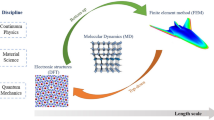Conclusions
The automated test system for computer-controlled low-cycle fatigue crack growth can be achieved using multi-task programming. The results of constant ΔJ test show the degree of success achieved with this system. This automated system integrates the ΔJ range in real time and controls it. It was shown that task priorities in the multi-task system gave great efficiency in developing the automated elastic-plastic fatigue crack growth system. The test system described herein was used to produce results of the constant ΔJ test for the material of JIS SM41B. The crack growth rates remained constant for many constant ΔJ tests as expected. This shows the effectiveness of the developed system. In these elastic-plastic crack growth rate experiments, the property of the closure load was also analyzed and was shown to be always compressive and to be a function of both the magnitude of ΔJ and crack length. An availability of such precise analysis for crack closure behavior is also a great advantage of using a multi-task system.
Similar content being viewed by others
References
Dowling, N.E. and Begley, J.A., “Fatigue Crack Growth During Gross Plasticity and the J-Integral,” Mechanics of Crack Growth, ASTM STP 590, 81–103 (1976).
El Haddad, M.H. and Mukherjee, B. “Elastic-Plastic Fracture Mechanics Analysis of Fatigue Crack Growth,” Elastic-Plastic Fracture: 2nd Symp., II, Fracture Resistance Curves and Engineering Applications, ASTM STP 803, 689–707 (1983).
Lambert, Y., Saillard, P. and Bathias, C., “Application of the J Concept to Fatigue Crack Growth in Large-Scale Yielding,” Fract. Mech.: 19th Symp., ASTM STP 969, 218–329 (1988).
Jablonski, D.A., “An Experimental Study of the Validity of a Delta J Criterion for Fatigue Crack Growth,” Nonlinear Fracture Mechanics: I-Time-Dependent Fracture, ASTM STP 995, 361–387 (1989).
Tanaka, T., Hoshide, T. and Nakata, M., “Elastic-Plastic Crack Propagation Under High Cyclic Stress,” Elastic-Plastic Fracture: 2nd Symp., II, Fracture Curves and Engineering Applications, ASTM STP 803, 708–722 (1983).
Joyce, J.A. and Sutton, G.E., “An Automated Method of Computer-Controlled Low-Cycle Fatigue Crack Growth Testing Using the Elastic-Plastic Parameter Cyclic J,” Automated Test Methods for Fracture and Fatigue Crack Growth, ASTM STP 877, 227–247 (1985).
Merkle, J.G. and Corten, H.T., “A J-Integral Analysis for the compact Specimen Considering Axial Force as Well as Bending Effects,” J. Press. Vessel Tech., Trans. ASME, 286–292 (Nov. 1974).
Iguchi, R., Interface, 15(140), 184–204 (1989) (in Japanese).
Clarke, G.A. and Landes, J.D., “Evaluation of J for the Compact Specimen,” J Test. and Eval., 7(5), 264–269 (Sept. 1979).
Author information
Authors and Affiliations
Rights and permissions
About this article
Cite this article
Sakai, S., Asakawa, T. & Okamura, H. Computer-controlled elastic-plastic fatigue crack growth testing using multi-task programming. Exp Tech 22, 26–31 (1998). https://doi.org/10.1111/j.1747-1567.1998.tb01281.x
Published:
Issue Date:
DOI: https://doi.org/10.1111/j.1747-1567.1998.tb01281.x




